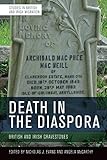Death in the Diaspora : British and Irish Gravestones / Nicholas Evans, Angela McCarthy.
Material type: TextSeries: Studies in British and Irish Migration : SBIMPublisher: Edinburgh : Edinburgh University Press, [2022]Copyright date: ©2020Description: 1 online resource (232 p.) : 43 B/W illustrationsContent type:
TextSeries: Studies in British and Irish Migration : SBIMPublisher: Edinburgh : Edinburgh University Press, [2022]Copyright date: ©2020Description: 1 online resource (232 p.) : 43 B/W illustrationsContent type: - 9781474473781
- 9781474473804
- British -- Funeral customs and rites
- British-Foreign countries-Social conditions
- Imperialism -- Social aspects
- Irish -- Funeral customs and rites
- Irish-Foreign countries-Social conditions
- Sepulchral monuments -- Commonwealth countries
- Sepulchral monuments-Great Britain-History
- Scottish Studies
- HISTORY / Europe / Great Britain / General
- 301.45 23
- GT3243
- online - DeGruyter
| Item type | Current library | Call number | URL | Status | Notes | Barcode | |
|---|---|---|---|---|---|---|---|
 eBook
eBook
|
Biblioteca "Angelicum" Pont. Univ. S.Tommaso d'Aquino Nuvola online | online - DeGruyter (Browse shelf(Opens below)) | Online access | Not for loan (Accesso limitato) | Accesso per gli utenti autorizzati / Access for authorized users | (dgr)9781474473804 |
Frontmatter -- Contents -- Figures and Tables -- The Contributors -- Acknowledgements -- Series Editors’ Introduction -- 1 Introduction – Death in the Diaspora: British and Irish Gravestones -- 2 Forgetting and Remembering: Scots and Ulster Scots Memorials in Eighteenth-century Ulster, Pennsylvania and Nineteenth-century New South Wales -- 3 Imposing Identity: Death Markers to ‘English’ People in Barbados, 1627–1838 -- 4 Looking for Thistles in Stone Gardens: The Cemeteries of Nova Scotia’s Scottish Immigrants -- 5 Scottish Gravestones in Ceylon in Comparative Perspective -- 6 Irish Memorialisation in South Australia, 1850–99 -- 7 Memorialising the Diasporic Cornish -- 8 Documents in Stone: Records of Lives and Deaths of Scots Abroad and in Scotland -- 9 Conclusion -- Index
restricted access online access with authorization star
http://purl.org/coar/access_right/c_16ec
A pioneering comparative study of migrant death markers across the British and Irish worlds and what they can tell us about notions of ‘home’Sets out an innovative agenda for comparative analysis of death markers in different parts of the formal and informal British EmpireProvides analyses based on hundreds of thousands of gravestones and memorial markers in the UK and Ireland, Australasia, Asia, Africa and the AmericasInvestigates the effects of religious identities in death and how they differ between memorials in Britain and IrelandAs British and Irish migrants sought new lives in the Caribbean, Asia, North America and Australasia, they left a trail of physical remains where settlement occurred. Between the 17th and 20th centuries, gravestones and elaborate epitaphs documented identity and attachment to their old and new worlds. This book expands upon earlier examination of cultural imperialism to reveal how individuals, kinship groups and occupational connections identified with place and space over time.With analyses based on gravestones and memorial markers in the UK and Ireland, Australasia, Asia, Africa and the Americas, the contributors explore how this evidence can inform 21st-century ideas about the attachments that British and Irish migrants had to ‘home’ – in both life and death.The book explores aspects of sociolinguistic difference evident in death markers and offers some insights into how growing literacy amongst migrant communities shaped the form of grave epitaphs. It expands upon earlier analyses of cultural imperialism to see how individual families and kinship groups identified with place and space over time and discusses how post-medieval archaeology from a range of death landscapes highlight difference rather than uniformity – including influences by Dutch, Jewish, Muslim and non-religious norms upon memorialisation practices. It also reveals how women and children, often marginalised voices in imperial scholarship, were as likely to be provided with more elaborate death markers than their male counterparts and challenges ideas of chain migration by demonstrating that families often moved to different, rather than similar, destinations overseas
Mode of access: Internet via World Wide Web.
In English.
Description based on online resource; title from PDF title page (publisher's Web site, viewed 27. Jan 2023)


